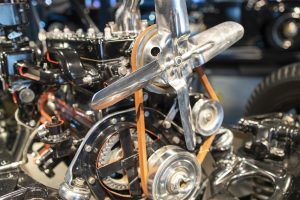As a vintage car enthusiast, it’s important to stay ahead of the game when it comes to maintaining and upgrading your beloved vehicle. One area that requires special attention is the cooling system. To ensure optimal performance and prevent overheating, there are several cooling system upgrades that every vintage car enthusiast should know about. In this article, we will explore the top five cooling system upgrades that will enhance your vintage car’s cooling capabilities and keep it running smoothly for years to come. So, let’s dive in and discover how these upgrades can take your vintage car experience to the next level!
Understanding the Cooling System
The cooling system in a vintage car consists of several components that work together to regulate engine temperature. These components include the radiator, water pump, thermostat, hoses, and coolant. Understanding how each part functions will help in effective maintenance and troubleshooting.
- Radiator Flushing and Cleaning
Regular radiator flushing and cleaning are essential to remove any debris or sediment that may accumulate over time. This buildup can obstruct the flow of coolant, leading to inefficient cooling and potential overheating. By flushing the radiator and cleaning it thoroughly, you ensure that the coolant circulates freely, dissipating heat effectively.
- Check and Replace Hoses
Inspecting the cooling system hoses is crucial to identify any signs of wear or damage. Over time, hoses can become brittle or develop cracks, resulting in coolant leaks. Regularly check the hoses for signs of degradation and replace them as needed. Ensure a proper seal by using quality hose clamps.
- Maintain the Water Pump
The water pump is responsible for circulating the coolant throughout the engine. To prevent overheating, it is essential to keep the water pump in good condition. Regularly inspect the pump for leaks or bearing failures. If any issues are detected, promptly replace the water pump to ensure efficient cooling system operation.
- Thermostat Inspection
The thermostat regulates the flow of coolant based on the engine’s temperature. Over time, the thermostat can become stuck or fail to open and close properly. This can lead to overheating or inadequate cooling. Regularly inspect and test the thermostat, replacing it if necessary, to maintain optimal engine temperature.
- Coolant Replacement
Periodically replacing the coolant is crucial for maintaining the cooling system’s effectiveness. Over time, coolant loses its protective properties and may become corrosive. Flushing out the old coolant and replacing it with fresh coolant will ensure proper engine cooling and prevent rust and corrosion.
Maintaining the Cooling System
Now that we understand the various components of the cooling system let’s delve into the maintenance practices that vintage car owners should follow:
- Regular Inspections
Perform visual inspections of the cooling system regularly. Look for any leaks, cracks, or signs of wear on hoses, the radiator, and the water pump. Detecting issues early on will allow for timely repairs, preventing potential overheating.
- Keep the Radiator Clean
Clean the radiator’s external fins and remove any debris or bugs that may obstruct airflow. Proper airflow is essential for effective cooling. Additionally, ensure that the radiator cap is in good condition and seals tightly to maintain proper pressure.
- Monitor Coolant Levels
Regularly check the coolant levels and top up as needed. Low coolant levels can lead to inadequate cooling and potential overheating. Ensure that the coolant mixture is appropriate for your vintage car and follow the manufacturer’s recommendations.
- Check Fan Operation
The cooling fan is responsible for drawing air through the radiator, aiding in heat dissipation. Ensure that the fan operates properly, engages at the correct temperature, and maintains the required speed. A malfunctioning fan can result in poor cooling performance.
- Maintain Proper Driving Habits
When driving a vintage car, it’s important to be mindful of how you operate the vehicle. Avoid excessive idling, as this can lead to overheating. Additionally, refrain from sudden acceleration and hard braking, as these actions put extra strain on the engine and cooling system.
Proper cooling system maintenance is crucial for vintage car owners to prevent overheating and ensure the longevity of their vehicles. By following the recommended practices outlined in this article, you can keep your classic car running smoothly and enjoy it for years to come. Remember to regularly inspect and maintain the cooling system components, replace coolant as needed, and practice good driving habits. With these measures in place, you can confidently hit the road in your vintage beauty, turning heads without worrying about overheating issues.
FAQs (Frequently Asked Questions)
Q: How often should I flush the radiator in my vintage car?
A: It is generally recommended to flush the radiator every two years or as specified in your car’s maintenance manual.
Q: Can I use any type of coolant in my vintage car?
A: No, it’s important to use a coolant that is compatible with your car’s requirements. Refer to the manufacturer’s recommendations or consult a professional.
Q: What should I do if my vintage car starts to overheat?
A: If your car starts to overheat, pull over to a safe location, turn off the engine, and allow it to cool down. Avoid opening the radiator cap when the engine is hot to prevent injury. Seek professional assistance if the problem persists.
Q: Are there any aftermarket cooling system upgrades available for vintage cars?
A: Yes, there are several aftermarket cooling system upgrades available, such as high-performance radiators, electric fans, and aluminum water pumps. Consult with experts to find the best options for your specific vintage car model.
Q: Can I use tap water instead of coolant in my vintage car’s cooling system?
A: It is not recommended to use tap water as it can contain minerals and impurities that may cause corrosion and damage to the cooling system. It’s best to use a mixture of distilled water and the recommended coolant.
